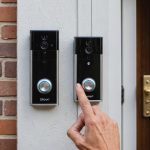Overview of Smart Video Doorbells
In today’s technologically savvy world, smart video doorbells are revolutionising home security, seamlessly blending convenience with protection. A smart video doorbell enhances traditional systems by offering real-time alerts and live video feeds directly to your smartphone. This allows homeowners to monitor and interact with visitors, from anywhere in the world.
The primary benefit of a smart video doorbell lies in its ability to deter unwanted guests, providing peace of mind with instant notifications whenever someone approaches your door. These devices bolster smart home security by integrating features such as motion detection, night vision, and two-way communication, enabling users to see and speak with visitors before granting access.
Also read : Maximize Your Smartphone’s Potential: A Comprehensive Guide to Smart Home Automation and Scheduling Mastery
When selecting a smart video doorbell, key features to consider include high-definition video quality, reliable motion detection, and robust network compatibility. These factors ensure that your device functions efficiently, offering seamless integration with your existing smart home security systems. Moreover, assessing factors like facial recognition, storage capacity for recordings, and weather resistance can greatly enhance your user experience and the overall effectiveness of your home security solution.
Ultimately, a smart video doorbell is an investment in safety, providing actionable insight and control over who enters your home.
Also to read : Seamless Living: Innovative Strategies for Merging Voice Assistants with Smartphone-Managed Smart Homes
Preparing for Installation
For a successful installation of your smart video doorbell, preparation begins with assessing smartphone compatibility. Ensure your device’s operating system supports the required app. This compatibility is crucial to access real-time alerts and updates, enhancing your smart home security. You can verify this by visiting the app store linked to your smartphone and reviewing the app’s system requirements.
Once compatibility is confirmed, gather the necessary tools and materials. Most installations require basic tools such as a screwdriver, drill, and wall anchors. Depending on your smart video doorbell model, additional tools might be needed, such as a level to ensure proper alignment. Accumulating these tools beforehand prevents delays and streamlines the installation process.
Choosing the best location for installing your smart video doorbell maximizes its functionality. The doorbell should be mounted at an optimal height—usually shoulder level—to capture a comprehensive view. Also, consider if the area has sufficient Wi-Fi coverage. This placement prevents connectivity issues and facilitates effective video monitoring. By thoroughly preparing, you set a solid foundation for integrating your smart video doorbell into your security system, simplifying the installation process.
Step-by-Step Installation Guide
Begin your doorbell installation by carefully reviewing the equipment and instructions that accompany your device. Understanding the specific installation steps tailored to your model is crucial for a smooth process.
Mounting the Smart Video Doorbell
Position the doorbell at the desired location, marking where it needs to be mounted. Use a level to ensure the doorbell is perfectly aligned. Drill pilot holes into the marked spots, then attach the mounting bracket securely. If the video doorbell features a quick-release mechanism, check it is functioning correctly before proceeding.
Connecting to Power
Depending on your model, you may need to decide between a hardwired or battery-operated setup. For hardwiring, carefully follow the instructions to attach the doorbell’s wires to your existing doorbell circuitry. Ensure all connections are secure to avoid future disruptions. For battery-operated versions, insert the fully charged battery pack as specified.
Connecting to Wi-Fi
Finally, ensure your smart video doorbell is within range of a strong Wi-Fi signal. Follow the instructions in the smartphone app setup to join your network. This step includes pairing your device and testing its functionality. Once successfully connected, the doorbell should alert you through the app, finalising the integration with your smart security network.
Smartphone Configuration
Configuring your smartphone for optimal integration with your smart video doorbell is crucial for smart home security. Start by downloading the designated smartphone app from your device’s app store. This app will serve as the core hub for your video doorbell’s features. Once downloaded, follow the app configurations prompts to create an account or log in if you already have one. Immediately pair your doorbell to the app by ensuring both your phone and the device are on the same Wi-Fi network.
Key settings to enhance doorbell performance should be adjusted within the app. Tweak notification preferences to decide alert types and frequencies that best suit your daily routine. Familiarise yourself with motion detection settings, adjusting sensitivity to reduce false alerts and optimise motion detection capabilities.
Should you encounter any troubleshooting challenges, such as connection issues, ensure your smartphone app and doorbell firmware are up-to-date. Restart the app or re-establish connectivity for persistent issues. Additionally, consult the manufacturer’s support portal through the app for troubleshooting tips tailored to specific problems. Adjust settings incrementally to maintain an efficient security system tailored to your needs.
Integrating with Smart Home Devices
Integrating smart video doorbells with other smart home devices enhances smart home security. Compatibility with platforms like Alexa and Google Home allows for seamless interoperability. Connecting your video doorbell to these systems lets you use voice commands for operations and integrates alerts into the broader smart home network.
To begin integration, access the smart home app of your choice and locate the option for adding new compatible devices. Select your doorbell model and follow the provided instructions. This setup typically involves connecting the doorbell and smart hub, ensuring they’re on the same Wi-Fi network. Once linked, you can explore automation opportunities, such as lights activating when motion is detected at the door. This enhances the practicality of video doorbell features.
Automation setups can simplify everyday routines. For example, you could configure smart locks to respond to the video doorbell, allowing remote control of entryways. Pairing a smart video doorbell with devices like smart speakers enables instant communication with visitors.
These integrations transform your smart video doorbell into a cornerstone of effective home automation, providing streamlined control and greater convenience. Consider what setups complement your lifestyle for optimal use of your smart home security infrastructure.
Troubleshooting Common Issues
Encountering challenges with your smart video doorbell is not uncommon, but solutions are readily available for most problems. Understanding what steps to take when facing common issues ensures your smart home security remains robust.
Video and Audio Issues
If you experience video lag or audio distortion, first test your internet speed. A slow connection can degrade the video doorbell’s performance. Ensure the device is within Wi-Fi range and consider upgrading your internet plan if speed tests show subpar results. Sometimes, restarting your doorbell or router can reset the connection, improving video and sound quality.
Connectivity Problems
Experiencing poor Wi-Fi connectivity often involves inspecting signal strength. Use a Wi-Fi analyser to identify potential interferences or weak spots in your network. Relocating your router closer to your doorbell can help or consider installing a Wi-Fi extender. Checking for app updates or resetting the device’s network settings can also resolve connectivity problems.
Battery Life Concerns
For battery-operated models, extending battery life involves reducing unnecessary alerts. Adjust motion detection and notification settings to balance alert frequency and battery consumption. Regular doorbell maintenance includes ensuring the camera lens and motion sensor are clean, preventing unwarranted activity requests.
Optimizing Doorbell Features
To make the most of your smart video doorbell, it is essential to keep its features optimized. Begin by focusing on motion detection settings. Adjusting the sensitivity helps to decrease false alerts that can clutter your notifications. Find a balance that accurately detects real visitors while ignoring inconsequential movements like swaying trees.
Notification customization is another critical aspect. Tailor these alerts to align with your lifestyle. For instance, enable notifications only during specific hours or days to avoid disturbances when you’re home. Such personalization ensures your video doorbell features work without becoming intrusive.
Regular maintenance is crucial for consistence in performance. Cleaning the camera lens and ensuring the firmware is up-to-date can significantly enhance smart home security. Performing these simple tasks ensures your doorbell functions at its best, providing clear and timely alerts.
By honing these elements, your doorbell not only integrates seamlessly but also serves as a reliable, proactive component of your home security. Keeping your device and preferences finely tuned means optimising both safety measures and device longevity, making it a robust piece of your security architecture.





